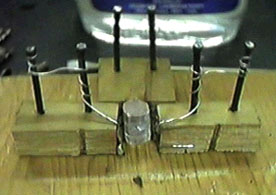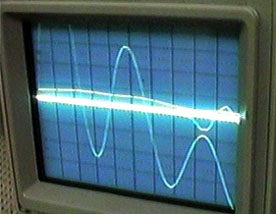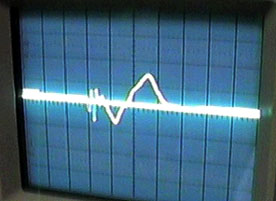A Piezoelectric Experiment
In a settup that wasn’t expected to work, piezoelectricity was well observed in Rochelle salt crystals. When the crystals were deformed (with the gentle tap of a piece of wood or hammer), short (on the order of 4 miliseconds) relatively hight voltage (maximum 20V peak to peak with 10M input Z to scope). It was surprising to see such well defined bursts of electricity (very low current).

The crystal was wedged into a home-made apparatus that held it in place and in contact with computer brush leads along the edges. A dab of mineral oil was placed on the contacts to help in their electrical connection. The results may astonish you

This first image is of a piezoelectric pulse on an oscilloscope set to 2 volts per division vertical and .1 milliseconds per division horizontal. This image clearly shows that a maximum voltage may be close to 20 volts.

This second image is of the same type of pulse with the time setting 1 millisecond per division. Judging from this image, the pulse lasted around 3.5 milliseconds.
While the crystal is depressed, current flows in one direction. When the crystal is released and springs back into its original form, the current flows in the other direction. A tap on the crystal can be thought of as producing one very tiny AC current cycle. The picture of the scope above clearly shows this.

